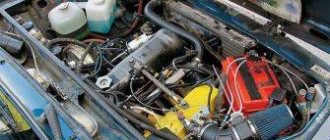Gas is cheaper than gasoline, but is it worth installing gas equipment on a carburetor car such as a VAZ-2106 or VAZ-2109? Cars are quite popular, so you need to figure out which LPG to choose and how to connect it.
HBO of the first generation is not much different from the second. The gas hose is connected to the carburetor through a spacer-mixer or directly through an insert into the carburetor. Under the influence of vacuum in the intake manifold, gas from the gearbox enters the carburetor through the dispenser.
Which gas pump to choose for a carburetor?
The only difference is the gas dispenser. On the first generation, the gas dispenser is manual, is set to the desired position once and requires adjustment no more often than a carburetor; and in the second generation, it is electronic, with a valve that is driven by a stepper motor depending on the readings of the oxygen sensor and the position of the carburetor throttle valve.
This second generation system is installed on cars with electronic carburetors - all sorts of Japanese ones from the 80s. We don’t need such bells and whistles on classic Soviet-designed carburetor cars, because they are more than completely useless. We throw away the electronic dispenser, install a mechanical one, and from an LPG of any generation we get a 1st generation LPG. What you need for a carburetor.
Standard equipment for gas equipment for carburetor engines
- Gas cylinder
- Multivalve
- Refilling device
- High pressure gas line
- Gas filter
- Gas valve
- Reducer-evaporator
- Dispenser
- Mixer (if no insertion was made into the carburetor)
- Gasoline valve
- Fuel switch
Operating principle and connection diagram
A gas cylinder is usually installed in the trunk, although on larger cars, like a GAZelle, the cylinder can be installed in other places without taking up useful space.
A multivalve is installed on the gas cylinder , which connects the cylinder with all other equipment. Through the multivalve, gas enters the cylinder, through which the gas enters the main line and then into the engine.
The remote filling device is installed in an easily accessible place so that it can be easily reached at the gas station, and a copper pipe line is laid from the VZU to the multivalve.
The high pressure gas line is the same copper tube leading from the multivalve towards the engine. But before that, the gas needs to be purified. Therefore, further along the line, a gas filter and a valve appear, stopping the gas supply when switching to gasoline or when stopping the engine.
The already purified gas enters
the evaporator reducer , in which the gas pressure is reduced to just over one atmosphere.
The peculiarity of gas evaporation is that it is cooled to sub-zero temperatures, passing from liquid to gaseous state, thereby cooling the gearbox. Therefore, sometimes you can see an icy gearbox. Such gas does not evaporate well and certainly cannot be used in the cold season. To solve this problem, the gearbox is heated with coolant from the cooling system.
This is why the car is started on gasoline, and then switched to non-gas - to warm up the coolant to heat the gearbox. And the gearbox is connected to the cooling system in front of the stove so that the coolant is hotter in winter.
Mechanical dispenser. Such a structure will be made in every village from available materials. After the evaporator there is a dispenser that regulates the amount of gas supplied to the engine. In our case with a carburetor engine, the dispenser will be mechanical.
The dispenser has a gas inlet, an outlet, an adjusting screw and a hole for a vacuum tube (not visible in this photo).
Using a vacuum tube, the metering device is connected to the manifold, so the higher the vacuum in the intake manifold, the more the metering device will open and the more gas will enter the engine. The feed can be adjusted using the adjusting screw.
Gas is supplied to the carburetor using a mixer , which is placed on top of the carburetor (first picture on this page), or using a direct insert into the carburetor, in both cases the gas is supplied directly to the carburetor chamber.
In order to turn off the gasoline pump, they place a valve on the gasoline line, and in injection systems they simply turn off the injectors (the gasoline then constantly circulates and all returns to the tank through the return line) or turn off the power to the gasoline pump.
The selection of the gas/gasoline power system is carried out using the gas/gasoline fuel switch, the switch of which is installed on the driver's seat. The operating principle is to shut off one type of fuel while simultaneously opening the supply of another type of fuel by opening/closing the fuel supply valves installed on the lines.
Features of installing 1st generation gas equipment on a carburetor car
From the gas valve a high pressure pipe goes to the reducer.
Here you can see that there is a high-pressure gas supply tube to the reducer, it is copper, and a low-pressure rubber hose comes from the reducer. The cooling system pipes are also connected (on the right). We disconnect the coolant supply pipe from the heater, connect it to the gearbox, and from the gearbox to the heater. So we powered the gearbox from the cooling system. Next, a regulator should be installed, for example, like this.
And from the regulator, gas flows to the carburetor through a spacer-mixer.
You can do it differently and do without this spacer, and simply cut the gas pipe into the carburetor.
Insertion of HBO into the carburetor
- We drill through holes in both chambers of the carburetor
- Cutting the thread
- Screw in the fittings
The carburetor is ready, you can see in the photo! All that remains is to connect the gas pipes.
Operating principle of HBO2
The principle of operation of 2nd generation HBO on a carburetor engine is as follows.
The gas is contained in a cylinder equipped with a multi-valve. Fuel is supplied to the valve using the main pipeline. Gas filtration systems are installed there. This is where it can be cleaned of dirt, debris and other foreign elements. Then comes the gearbox. It is connected to a system that is needed to cool the engine. In it, the gas changes form from water to steam. This is achieved through temperature and pressure. The gas is supplied as steam to the engine to be mixed with air.
Now the fuel enters the mixer. There, gasoline and air are mixed to create a mixture. A power regulator is installed on the sleeve. It is needed to regulate the amount of gasoline in the engine. If the mode operates on gas, the gasoline supply will intersect with the valve located on the fuel line.
Note. To prevent the pump from constantly breaking down, a gasoline valve should be placed between the gasoline pump and the carburetor. This is necessary so that the first one contains gasoline necessary for lubrication.
The HBO button is responsible for controlling the system. If the ignition is turned off, the switch is de-energized and the fuel is shut off.
The connection diagram consists of three modes:
- Gaza. When the ignition is turned on, the switch receives energy, opening access to the fuel supply. This is necessary to improve the launch. Pulses will appear on the ignition coil. The switch will see them and open access to the valve. Fuel will flow until the wire stops receiving signals.
- Gasoline. No fuel will be supplied here. Power will be supplied to the gas valve, which will open the flow of gasoline to the engine.
- Transition. Here the supply of both fuel options will be turned off.
You might be interested >> Eyelets for padlocks: what are they and why are they needed?
HBO 2nd generation for carburetor
Most people do not know what HBO is and what its functions are. In this article you can learn about the principle of its operation, as well as how to correct problems with this equipment.
HBO 2 for a carburetor engine
LPG is a vehicle's gas equipment. There are two types of engines - carburetor and injection. They are different from each other. The first one sucks in gasoline and air using pressure. In this case, remote control is either very low or absent altogether.
And the injector allows you to inject gasoline into the engine using nozzles. All processes are controlled using an on-board computer. Using pressure sensors, as well as oxygen and temperature beams, it obtains information.
Installation of HBO2
To install a carburetor in a VAZ 2106, we need to open the hood. The valve and reducer are located there. They are connected to each other. The high pressure fuel line must be connected to the valve. Such lines must be made of copper. If it has low pressure, it is necessary to use rubber hoses with gas.
A pipe from the cooling system must be connected to the corrector gearbox. The gearbox can be installed on the right, next to the stove.
For information on adjusting the 2nd generation Tomasetto LPG gearbox, please follow the link.
Note. If you install it near the stove, you will benefit, since the stove will help warm up the gearbox faster.
To establish a connection to the cooling system, you need:
- Disconnect the pipe that is connected to the stove radiator.
- Install it from the pump to the gearbox housing. This is necessary to supply hot antifreeze.
- Install another pipe from the stove tap to the gearbox.
After this, you need to adjust the regulator and start supplying gas to the carburetor. There are two ways to supply gas fuel:
- Using a mixing spacer.
- Using a carburetor insert.
For the second method, you need to make several holes in the carburetor chamber. Threads are cut into them and special fittings are screwed into them. The latter are needed to connect the gas pipe.
You can install HBO2 on the carburetor yourself.
"Turtle"
The appearance of the mixer resembles a turtle. To install it, you do not need to dismantle the carburetor. Unscrew the fastening nuts on the air filter, remove the pressure plate and install the turtle. Then all the nuts are returned to their place. This installation requires one modification. To create a gas line, a hole is drilled in the filter housing. The adjustment is carried out using a dispenser having:
- entrance;
- exit;
- adjusting bolt.
Unfortunately, working on gas leads to a decrease in power by approximately 7%, regardless of the type of fuel (propane, liquefied gas). This occurs due to a reduction in the diameter of the passage through which the air flow enters. Setting the gas-air mixture in this case is much more difficult. The mixture can be highly oversaturated or “lean”. This simple installation can be used for various types of carburetors:
- ozone;
- daaz;
- Weber.











